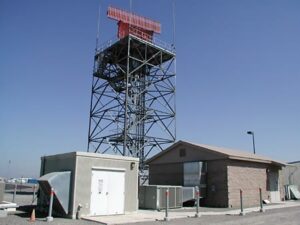As the U.S. government prepares for unmanned aerial systems (UAS) in the National Airspace System by 2015, the U.S. Air Force and Raytheon Company have conducted concept evaluation demonstrations that show existing air traffic control equipment could be modified to safely track the presence of nearby unmanned aircraft.
Ground Based Sense and Avoid (GBSAA) — based on the Airport Surveillance Radar Model-11 (ASR-11) and the repurposed Standard Terminal Automation Replacement System (STARS) air traffic control system — reduces the need for costly new infrastructure.
The testing near Edwards Air Force Base at Gray Butte Airfield in California involved a moving “dynamic protection zone” — a collision avoidance alerting capability — around the UAS. The “dynamic protection zone” provides a series of alerts to the UAS pilot as airborne objects (i.e., balloons or ultra-lights) approach to avoid near mid-air collisions. GBSAA also builds on wind farm mitigation technology used to mitigate interference from wind turbines near airports.
Using Raytheon’s ASR-11, the STARS automation system, and its surveillance data processor, repurposed for GBSAA, pilots and controllers were given alerts of intruding airborne objects near surrogate unmanned aerial systems and were able to keep them safely separated.
ASR-11, the STARS system and its surveillance data processor are proven, NAS-certified systems for use in safely separating aircraft today. Repurposing these assets provides a cost-effective approach that enables safe UAS flight in the NAS.
“Our solution provides the Federal Aviation Administration and the Department of Defense with a cost-effective and safe approach to handle the thousands of unmanned aerial systems that’ll be flying in our airspace in the next few years,” said Joseph Paone, director of Air Traffic Management for Raytheon’s Network Centric Systems business.
“Our system properly notifies controllers and pilots of intrusions and accurately shows aircraft altitude, which is important in keeping commercial aircraft, unmanned aerial systems and other hazards safely separated,” he added.
Leveraging the existing NAS-certified installed-base of ASR-11 and STARS systems, Raytheon will continue testing GBSAA with the U.S. Air Force at other sites across the country.



















